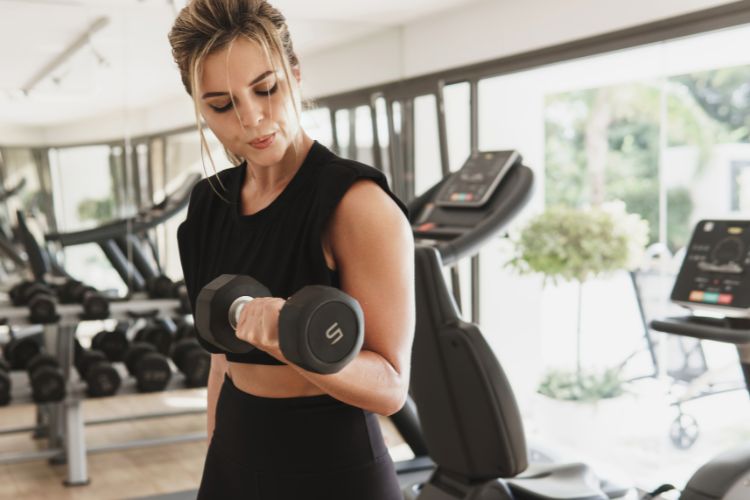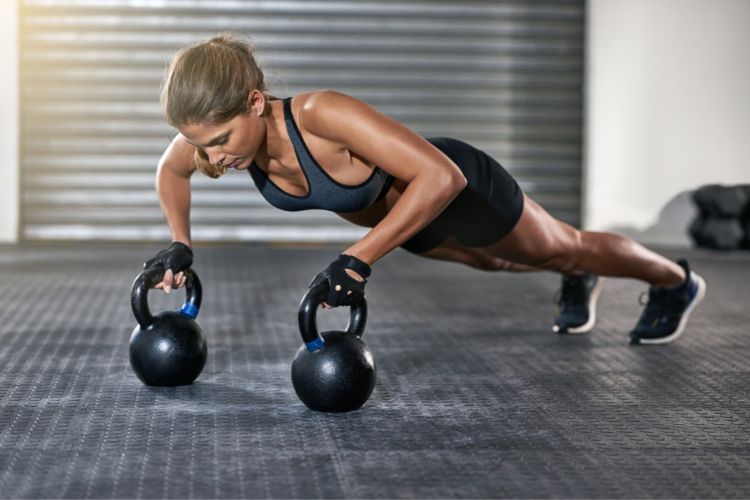Functional Strength Training Exercises A Guide For Women
Functional strength training has gained popularity as a fitness approach that emphasizes movements mimicking everyday activities. This form of training helps women improve their physical performance, posture, balance, and core stability. Unlike traditional weightlifting, functional strength training focuses on exercises that activate multiple muscle groups and enhance coordination, making it an ideal choice for women of all fitness levels.
Below, we’ll delve into the benefits of functional strength training, the best exercises to incorporate, and tips for creating a balanced workout plan.
What is Functional Strength Training?
Functional strength training involves exercises that train muscles to work together while simulating common movements you might perform at home, work, or in sports. These movements often occur across multiple planes of motion, requiring stability, strength, and mobility.
Key Features of Functional Training:
- Compound Movements: Engages multiple muscle groups simultaneously.
- Improved Mobility: Enhances range of motion for better physical performance.
- Balance and Coordination: Develops stability to prevent falls and injuries.
- Core Engagement: Builds a strong, stable core for overall body strength.
Functional exercises are practical and adaptable, making them an excellent fit for women at various fitness levels, whether you’re a beginner or an experienced athlete.
Benefits of Functional Strength Training for Women
1. Improved Everyday Functionality
By mimicking real-life movements, functional strength exercises enhance your ability to carry out daily tasks like lifting, bending, and reaching with ease and safety.
2. Injury Prevention
Functional training focuses on building stability and balance, reducing the risk of injuries during activities and workouts.
3. Core Stability
A strong core is essential for almost every movement. Functional exercises prioritize core engagement, improving posture and reducing back pain.
4. Efficient Workouts
Many functional exercises combine strength and cardio, offering a full-body workout in less time.
5. Increased Confidence
Building strength and mastering complex movements can boost self-confidence and empower women to take on physical challenges.
The Best Functional Strength Training Exercises for Women
Here’s a list of essential functional strength exercises designed to build full-body strength, enhance mobility, and improve balance.
1. Squats
Why They’re Functional:
Squats mimic the movement of sitting and standing, a daily activity for everyone. They work the lower body, including quads, glutes, hamstrings, and core.
How to Perform:
- Stand with your feet shoulder-width apart.
- Lower your body by bending your knees and pushing your hips back, keeping your chest upright.
- Return to the starting position by pressing through your heels.
Variations:
- Bodyweight Squats (Beginner)
- Goblet Squats (Intermediate)
- Barbell Back Squats (Advanced)
2. Deadlifts Functional Strength Training Exercises
Why They’re Functional:
Deadlifts simulate picking objects off the ground, strengthening the posterior chain, including the hamstrings, glutes, and lower back.
How to Perform:
- Stand with feet hip-width apart, with a dumbbell or barbell in front of you.
- Hinge at your hips and lower your torso while keeping your back straight.
- Grab the weight and lift it by extending your hips and knees simultaneously.
Variations:
- Romanian Deadlifts (Focus on hamstrings)
- Single-Leg Deadlifts (Improve balance)
- Kettlebell Deadlifts (Versatile option)
3. Lunges Functional Strength Training Exercises
Why They’re Functional:
Lunges replicate the movement of stepping and climbing stairs, making them essential for building lower body strength and balance.
How to Perform:
- Step one foot forward and lower your body until both knees form 90-degree angles.
- Push back to the starting position and alternate legs.
Variations:
4. Push-Ups Functional Strength Training Exercises
Why They’re Functional:
Push-ups strengthen the chest, shoulders, triceps, and core, mimicking the action of pushing objects.
How to Perform:
- Start in a high plank position, with hands slightly wider than shoulder-width apart.
- Lower your chest toward the floor while keeping your core tight.
- Push back up to the starting position.
Variations:
- Knee Push-Ups (Beginner)
- Incline Push-Ups (Modified intensity)
- Plyometric Push-Ups (Explosive power)
5. Plank
Why It’s Functional:
Planks are a foundational exercise for core stability, improving posture and supporting other movements.
How to Perform:
- Get into a forearm plank position with your elbows under your shoulders.
- Keep your body in a straight line from head to heels.
- Hold the position while maintaining a tight core.
Variations:
- Side Plank (Target obliques)
- Plank with Shoulder Taps (Add stability)
- Plank to Push-Up (Dynamic transition)
6. Kettlebell Swings Functional Strength Training Exercises
Why They’re Functional:
This exercise builds explosive power, strengthens the posterior chain, and boosts cardiovascular endurance.
How to Perform:
- Stand with feet slightly wider than hip-width apart, holding a kettlebell with both hands.
- Hinge at your hips and swing the kettlebell back between your legs.
- Drive your hips forward to swing the kettlebell to shoulder height.
Tips:
Start with a lighter kettlebell to master form before progressing to heavier weights.
7. Pull-Ups (or Assisted Pull-Ups) Functional Strength Training Exercises
Why They’re Functional:
Pull-ups improve upper body strength, particularly in the back, shoulders, and arms, and mimic pulling movements.
How to Perform:
- Grab a pull-up bar with palms facing away.
- Engage your core and pull yourself up until your chin is above the bar.
- Lower yourself back down with control.
Assistance:
Use resistance bands or an assisted pull-up machine if necessary.
8. Farmer’s Carry
Why It’s Functional:
Carrying heavy loads builds grip strength, core stability, and overall endurance.
How to Perform:
- Hold a dumbbell or kettlebell in each hand.
- Walk forward with your shoulders back and core tight.
- Continue for a set distance or time.
9. Medicine Ball Slams Functional Strength Training Exercises
Why They’re Functional:
This full-body exercise develops power, coordination, and endurance.
How to Perform:
- Hold a medicine ball above your head with both hands.
- Slam it down to the ground with force, engaging your core and arms.
- Pick it up and repeat.
10. Step-Ups
Why They’re Functional:
Step-ups mimic climbing stairs, improving leg strength and stability.
How to Perform:
- Stand in front of a sturdy box or bench.
- Step one foot onto the box and push through your heel to lift your body up.
- Step back down and alternate legs.
Creating a Functional Strength Training Exercises Routine
Warm-Up
Before diving into your workout, prepare your body with dynamic stretches and mobility exercises. Spend 5-10 minutes performing moves like:
- Arm Circles
- Leg Swings
- High Knees
- Cat-Cow Stretch
Sample Weekly Functional Strength Training Exercises Routine
Day 1: Lower Body Focus
- Squats: 3 sets of 12 reps
- Deadlifts: 3 sets of 10 reps
- Walking Lunges: 3 sets of 12 reps per leg
- Farmer’s Carry: 3 sets of 30 seconds
2: Upper Body and Core
- Push-Ups: 3 sets of 10-15 reps
- Pull-Ups (or Assisted): 3 sets of 8-10 reps
- Plank with Shoulder Taps: 3 sets of 20 taps
- Medicine Ball Slams: 3 sets of 15 reps
3: Active Recovery
- Yoga or light stretching
- Walking or swimming
4: Full-Body Power
- Kettlebell Swings: 3 sets of 20 reps
- Step-Ups: 3 sets of 10 reps per leg
- Plank to Push-Up: 3 sets of 10 reps
- Jump Squats: 3 sets of 15 reps
Tips For Success In Functional Strength Training Exercises
- Focus on Form: Prioritize proper technique to avoid injuries.
- Start with Bodyweight: Master bodyweight exercises before incorporating weights.
- Progress Gradually: Increase resistance or intensity as your strength improves.
- Incorporate Variety: Rotate exercises to prevent plateaus and keep workouts engaging.
- Listen to Your Body: Take rest days when needed and adjust intensity based on your energy levels.
Functional strength training exercises is a transformative workout style that helps women build strength, improve daily performance, and boost overall fitness. By incorporating the exercises and routines outlined above, you can create a well-rounded program tailored to your goals. Whether you’re looking to enhance athletic performance, prevent injuries, or simply feel more confident in your movements, functional training is a powerful tool for achieving sustainable fitness success.
Most Recommended





